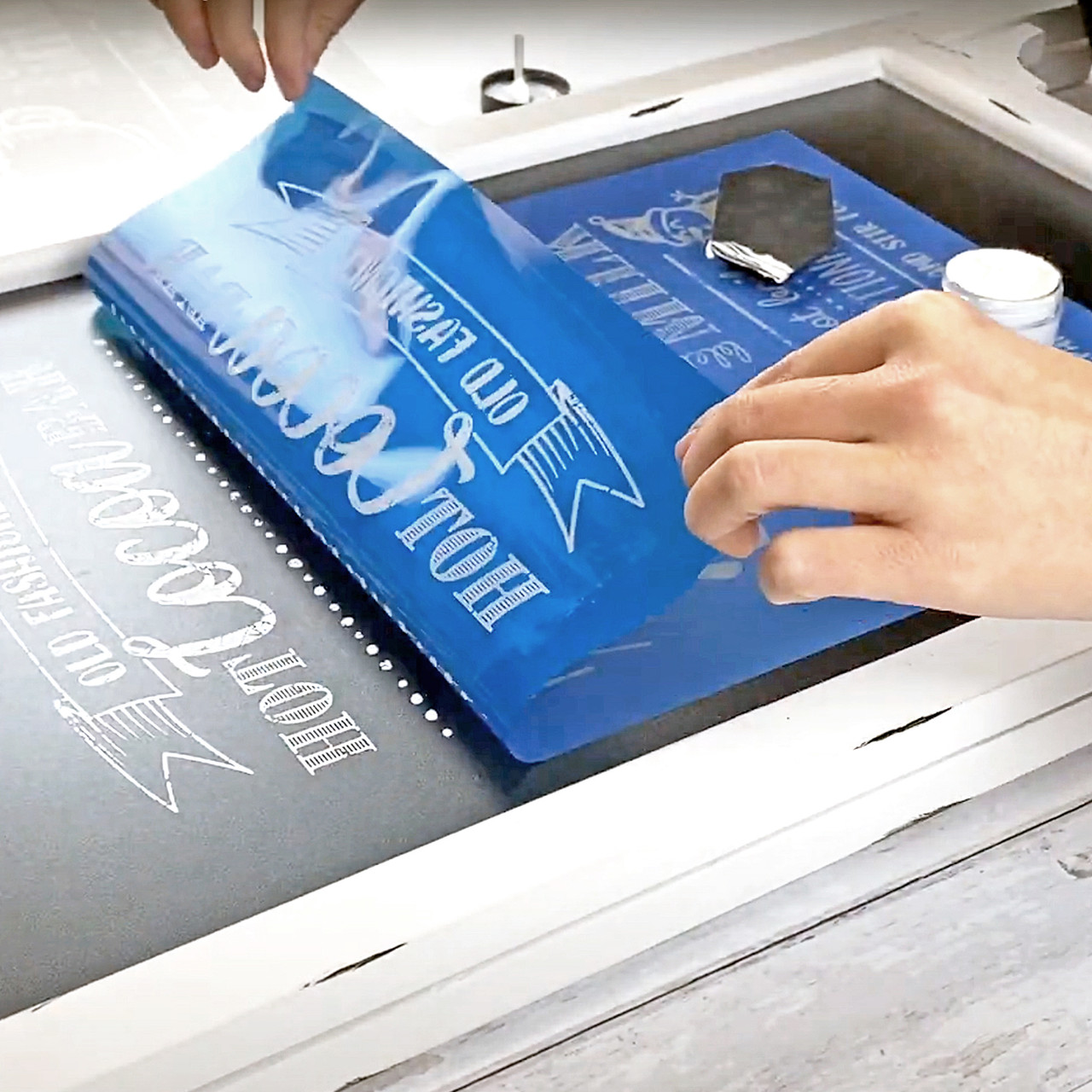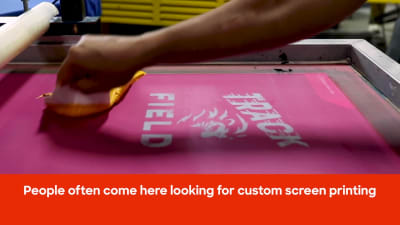High-Volume T-Shirt Printing for Schools and Organizations
High-Volume T-Shirt Printing for Schools and Organizations
Blog Article
Display Printing Uncovered: Whatever You Required to Know Regarding T-Shirt and Garment Printing Methods
Screen printing is an interesting technique that integrates art with technique, providing countless opportunities for creativity. Prepared to discover the important aspects that make display printing an art kind?
The Essentials of Display Printing: How It Functions
When you dive right into screen printing, you'll uncover it's both a scientific research and an art. At its core, screen printing entails creating a stencil, or display, that enables ink to pass through just in specific areas.
Position the display over the textile, after that make use of a squeegee to push ink with the display onto the garment. Each step is necessary, and grasping them will certainly boost your screen printing skills, transforming simple garments right into one-of-a-kind, expressive pieces.
Sorts Of Screen Printing Strategies
As soon as you understand the basics of screen printing, it's time to check out the various methods that can boost your styles. One popular approach is standard screen printing, where ink is pressed via a stenciled display. This strategy is wonderful for bold, dynamic colors. There's water-based ink printing, which provides a softer feeling and is environmentally friendly, yet it calls for a different strategy to treating.
An additional choice is plastisol printing, recognized for its toughness and dazzling colors, making it a preferred for lots of brand names. Experiment with halftone printing to produce gradient impacts and elaborate layouts.
Necessary Devices for Screen Printing
To accomplish spectacular lead to display printing, having the ideal tools is essential. First, you'll need a durable screen printing frame, which holds the mesh that moves your design onto the garment. Next off, buy premium mops; these are vital for using ink evenly throughout the display. You'll also call for a great exposure device to create your screens, in addition to a washout booth for cleaning them after use. A trustworthy warm source, like a conveyor clothes dryer or heat press, is essential for treating your prints to guarantee longevity. Don't neglect a proper office, geared up with tables and storage space for your products. Lastly, protective gear, such as gloves and masks, will certainly maintain you risk-free from chemicals and inks. With the right devices, you'll be well on your way to producing professional-quality prints.
Selecting the Right Inks and Materials
When choosing inks and products for screen printing, you require to take into consideration the kind of ink that functions finest for your project. Believe regarding material compatibility to guarantee your designs look last and terrific long. Check out eco-friendly ink options to make your printing procedure a lot more sustainable.
Kinds Of Screen Inks
Picking the right display ink is necessary for achieving dynamic, sturdy prints that meet your task's needs. There are a number of kinds of display inks to analyze. Specialized inks, such as metallic or glow-in-the-dark, can add special impacts to your styles.

Material Compatibility Considerations
Understanding fabric compatibility is vital for attaining premium screen prints, especially considering that various materials respond distinctly to various inks. When selecting inks, think about the fabric kind-- cotton, polyester, or blends. For cotton, water-based inks work well, using soft qualities and breathability. Polyester, on the other hand, typically requires plastisol inks for far better attachment and vivid shades. You may need to use a mix of both types if you're printing on blends. Constantly examine your inks on example material to assure they stick correctly and keep shade integrity. Additionally, remember that material weight and structure can influence the last result, so picking the ideal ink and material combination is important for your project's success.
Eco-Friendly Ink Options
Environment-friendly inks are coming to be a preferred choice for screen printers that want to decrease their environmental influence while preserving high quality. When choosing inks, think about water-based inks, which are less harmful and simpler to clean up compared to traditional solvents.
Additionally, look for inks made from renewable energies, such as soy or vegetable-based alternatives. By choosing the ideal inks and materials, you'll not only create stunning designs however likewise add to a more lasting printing procedure. Make the button, and your prints will certainly show your commitment to the setting!
Preparing Your Style for Screen Printing

File Layout Demands
To assure your design t-shirt printing looks vibrant and sharp on material, you'll need to pay attention to file layout requirements for display printing. Begin with vector documents like AI or EPS, as they can be scaled without shedding quality. If you make use of raster photos, select high-resolution data, such as TIFF or PNG, preferably at 300 DPI. Stay clear of utilizing JPEGs, as they can shed clarity when resized. Make sure your style has a clear history to protect against undesirable white sides on your prints. Maintain shade modes in mind; CMYK is standard for display printing, so transform your RGB creates accordingly - screen printing kit. By following these standards, you'll establish your art work up for an effective print.
Shade Splitting Up Methods
Shade separation is an essential step in preparing your layout for screen printing, and grasping it can greatly boost your print top quality. You'll need to break your layout into individual colors, as each color needs a separate display during printing. Start by recognizing all the colors in your layout and create layers for each one. You can utilize software like Adobe Photoshop or Illustrator to separate and separate shades effectively. Be specific to conserve each layer as a separate file, usually in a layout like TIFF or PSD. This precision not only guarantees accurate color depiction yet additionally enhances the printing process. By focusing on shade separation, you'll achieve lively and professional results in your screen-printed garments.
Resolution and Dimension
Achieving the very best lead to screen printing begins with assuring your layout has the right resolution and size. Preferably, your artwork ought to be at the very least 300 DPI (dots per inch) for sharp, clear prints. If you use reduced resolution, your last product may look pixelated and amateur.
When it concerns size, think about the measurements of your print location. Style your artwork to match the last print dimension, ideally creating it in the real measurements you'll be publishing. By doing this, you'll stay clear of any kind of unanticipated scaling problems.
Always inspect your style in both vector and raster layouts. Vector graphics can be scaled without shedding top quality, making them optimal for screen printing. Preparing properly will ensure your layout looks fantastic on every garment!
Step-by-Step Display Printing Refine
Screen printing is a dynamic process that allows you to produce dynamic styles on numerous surfaces. To get begun, you'll need a screen, solution, and your chosen ink. Initially, prepare your display by cleaning it completely. Next, apply the solution equally and let it dry in a dark location. As soon as dry, subject your screen to light with your design placed on it, which will certainly set the solution where the light hits, developing a pattern - screen printing kit.
Put ink onto the screen and make use of a squeegee to push the ink via the pattern onto the fabric. Lift the screen carefully and allow the print completely dry. You've efficiently display printed your layout.
Tips for Effective Screen Printing Projects
While you're diving into your display printing jobs, bear in mind that preparation is essential to success. Start by collecting all your click now materials-- inks, garments, displays, and mops. A clean workspace helps avoid unwanted errors, so clean before you begin.
Following, verify your art work is high-resolution and appropriately why not look here sized for your garment. Check your display for correct direct exposure and clean it thoroughly to avoid smudges. When blending your inks, comply with the maker's standards to achieve the best uniformity.
Throughout printing, use also pressure with your squeegee for constant results. Don't rush; take your time to verify each print satisfies your requirements. After printing, let your garments dry entirely before dealing with or packaging them.
Finally, constantly keep a sample of your job for future reference. In this manner, you can analyze your development and enhance your techniques over time. Satisfied printing!

Regularly Asked Inquiries
For how long Does It Require To Establish a Screen Printing Job?
Establishing a screen printing work commonly takes about thirty minutes to an hour. You'll prepare the screens, mix inks, and change journalism. The time differs based on complexity and experience, so remain organized!
Can I Print on Various Textile Enters Utilizing the Exact Same Technique?
Yes, you can publish on different fabric types making use of the same technique, yet you'll need to readjust your setups and inks. Some fabrics take in ink differently, so trying out guarantees the ideal outcomes for every product.
What Prevail Errors to Avoid in Display Printing?
When display printing, stay clear of typical errors like using the wrong ink, ignoring correct exposure times, or missing pre-press checks. Constantly examine your setup and preserve clean screens to ensure quality results each time.
Exactly How Can I Correctly Clean and Preserve My Display Printing Equipment?
To effectively clean and preserve your display printing equipment, you should consistently clean displays with suitable solvents, inspect mops for wear, and assure all devices are stored completely dry and dust-free. Consistency enhances and avoids costly repair services performance.
Is Display Printing Ecologically Pleasant Contrasted to Various Other Techniques?
Display printing can be more eco-friendly than various other methods, specifically if you make use of water-based inks and eco-conscious products. By picking sustainable materials and practices, you decrease waste and reduce your effect on the earth.
Display Printing Uncovered: Everything You Need to Know Concerning Tee Shirt and Garment Printing Strategies
At its core, screen printing involves creating a pattern, or screen, that enables ink to pass via just in details locations. Setting the display over the textile, then make use of a squeegee to push ink with the screen onto the garment. One popular technique is conventional screen printing, where ink is pressed through a stenciled display.When picking inks and products for display printing, you need to take into account the type of ink that functions finest for your job.
Report this page